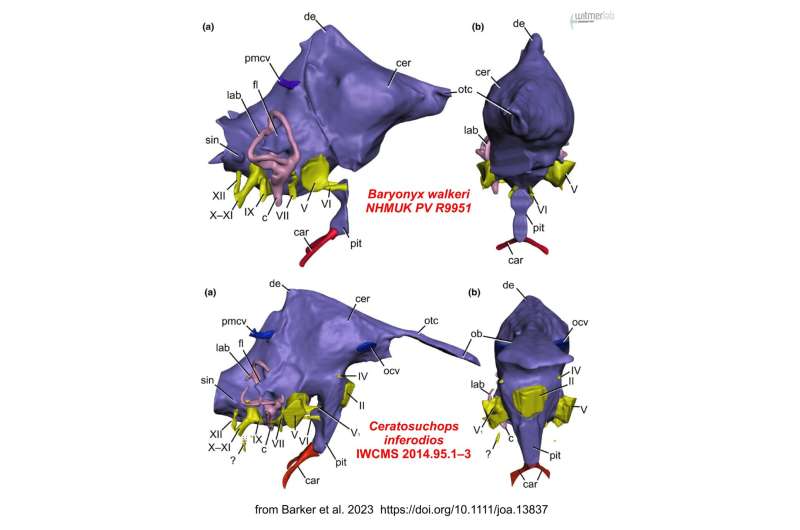Researchers reveal evolution of oldest Spinosaur brains
Researchers from Ohio University and the University of Southampton have reconstructed the brains and inner ears of two British spinosaurs, helping uncover how these large predatory dinosaurs interacted with their environment.
俄亥俄大学和南安普顿大学的研究人员重建了两只英国棘龙的大脑和内耳,帮助揭示了这些大型掠食性恐龙是如何与环境相互作用的。
Lawrence M. Witmer, professor of anatomy at OHIO’s Heritage College of Osteopathic Medicine, and Ryan Ridgley, a research associate of 23 years in WitmerLab, specifically focused their research efforts and contributed information on Baryonyx, one of the species of spinosaurs highlighted in the study.
俄亥俄州传统骨科医学院(Heritage College of Osteopathic Medicine)的解剖学教授劳伦斯·M·维特默(Lawrence M. Witmer)和在维特默实验室(WitmerLab)工作了23年的助理研究员瑞安·里奇利(Ryan Ridgley),特别专注于他们的研究工作,并提供了有关重石龙(Baryonyx)的信息,重石龙是研究中重点关注的棘龙物种之一。
The most famous spinosaur is Spinosaurus itself, a 45-foot-long, sail-backed giant that was one of the stars of Jurassic Park III. Spinosaurs are an unusual group of theropod dinosaurs, equipped with long, crocodile-like jaws and conical teeth. These adaptations helped them live a somewhat-aquatic lifestyle that involved stalking riverbanks in quest of prey, among which were large fish. This way of life was very different from that of more familiar theropods, like Allosaurus and Tyrannosaurus.
最有名的是棘龙本身,一个45英尺长,帆背的巨人,是侏罗纪公园III的明星之一。棘龙是一种不寻常的兽脚亚目恐龙,长着像鳄鱼一样的长颌和锥形牙齿。这些适应有助于它们过一种水生的生活方式,包括在河岸上寻找猎物,其中包括大鱼。这种生活方式与我们熟悉的异特龙和暴龙等兽脚亚目恐龙非常不同。
To better understand the evolution of spinosaur brains and senses, the team scanned fossils of Baryonyx from Surrey and Ceratosuchops from the Isle of Wight. These two are the oldest spinosaurs for which braincase material is known. The huge creatures lived long before Spinosaurus and would have been roaming the planet about 125 million years ago. The braincases of both specimens are well preserved, and the team digitally reconstructed the internal soft tissues that had long rotted away.
为了更好地了解棘龙的大脑和感官的进化,研究小组扫描了萨里郡的重石龙和怀特岛的角鼻龙的化石。这两只是已知脑壳材料的最古老的棘龙。这种巨大的生物早在棘龙之前就存在了,大约在1.25亿年前就已经在地球上漫游了。这两个标本的脑壳都保存得很好,研究小组用数字技术重建了腐烂已久的内部软组织。
The researchers found the olfactory bulbs, which process smells, weren’t particularly developed, and the ear was probably attuned to low frequency sounds. Those parts of the brain involved in keeping the head stable and the gaze fixed on prey were possibly less developed than they were in later, more specialized spinosaurs.
研究人员发现,处理气味的嗅球并没有特别发达,耳朵可能对低频声音很敏感。大脑中那些与保持头部稳定和注视猎物有关的部分,可能比后来更专业化的棘龙发育得更慢。
Findings were recently published in a freely accessible article in the Journal of Anatomy.
研究结果最近发表在《解剖学》杂志上的一篇文章中。
“Despite their unusual ecology, it seems the brains and senses of these early spinosaurs retained many aspects in common with other large-bodied theropods—there is no evidence that their semi-aquatic lifestyles are reflected in the way their brains are organized,” said University of Southampton Ph.D. student Chris Barker, who led the study.
南安普顿大学的博士生克里斯·巴克领导了这项研究,他说:“尽管它们的生态环境不同寻常,但这些早期棘龙的大脑和感官似乎与其他大型兽脚亚纲动物保留了许多共同之处——没有证据表明它们的半水生生活方式反映在它们的大脑组织方式上。”
One interpretation of this evidence is that the theropod ancestors of spinosaurs already possessed brains and sensory adaptations suited for part-time fish catching, and that ‘all’ spinosaurs needed to do to become specialized for a semi-aquatic existence was evolve an unusual snout and teeth.
对这一证据的一种解释是,棘龙的兽脚亚目祖先已经拥有了适合兼职捕鱼的大脑和感官适应能力,而为了适应半水生生活,棘龙所需要做的“全部”就是进化出不寻常的鼻子和牙齿。

英国棘龙(下)和重晶石(上)的脑内皮(紫色)、脑神经(黄色)、内耳(粉色)和血管(红色和蓝色)的三维重建。来源:克里斯·巴克
“Because the skulls of all spinosaurs are so specialized for fish-catching, it’s surprising to see such ‘nonspecialized’ brains,” said contributing author Dr. Darren Naish. “But the results are still significant. It’s exciting to get so much information on sensory abilities—on hearing, sense of smell, balance and so on—from British dinosaurs. Using cutting-edged technology, we basically obtained all the brain-related information we possibly could from these fossils,” Dr. Naish said.
“因为所有棘龙的头骨都是专门用于捕鱼的,所以看到这样‘非专业’的大脑令人惊讶,”特约作者达伦·奈什博士说。“但结果仍然很重要。从英国恐龙身上获得这么多关于听觉、嗅觉、平衡等感官能力的信息是令人兴奋的。利用尖端技术,我们基本上从这些化石中获得了所有可能的与大脑有关的信息,”奈什博士说。
Read more at Phys.org
在Phys.org阅读更多











